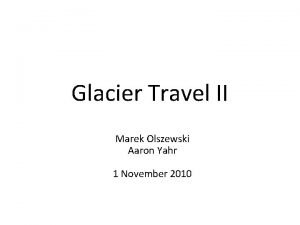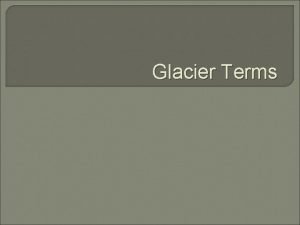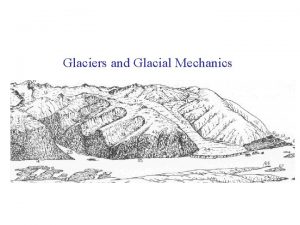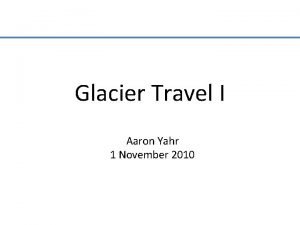Glacier Travel II Marek Olszewski Aaron Yahr 1









- Slides: 9

Glacier Travel II Marek Olszewski Aaron Yahr 1 November 2010

Reference Outline • Gear • Prussiks • Anchors • Belay Systems • Ascending the rope

What to bring • Ropes: – Dry treated ropes absorb less water so are lighter, and handle better when frozen • 8. 5 - 9 mm generally thick enough for falls into crevasses with packs • But, the glacier is usually one part of the climb, if you're doing any technical climbing higher up, you'll need a standard 10 -11 mm rope or two smaller ropes for double or twin climbing. • Harness: – Adjustable leg loops are useful since you may have more insulation • Loops that can be completely undone are also nice • If you have a heavy pack, a chest harness is also useful, can be made from a piece of 1 inch webbing

What to bring… • Prusiks – 5 to 7 mm perlon accessory cord – Attach to climbing rope with friction knot • Moves freely when loose • Grips firmly when weighed • Usually use prusik knot – Also like Bachmann friction knot because it uses a carabiner which makes a good handle. • Used for ascending the rope after a crevasse fall, or for self belaying yourself along a rope. • May also use an Etrier (aka Aider), and/or mechanical ascenders

What to bring… • Pulleys – For building rescue hauling systems. – Carabiner can be used too, but adds friction • Anchor – Snow or Ice anchors depending on conditions • Runners – Bring at least 2 single-length and one double-length runner for attaching to anchors – Tied runners are better than sewn runners because you can more easily adjust their length • Belay device • Carabiners – Recommend at least one locking, and 4 non-locking

Chest Harness • Chest Harness: – Helps you stay upright if you fall into a crevasse with a heavy pack - But makes it harder to self arrest - Good rule of thumb: - Clip rope into chest harness when crossing snow bridge, and keep unclipped otherwise

Prusik Slings • Attach slings to rope when roping up – A set consists of a short and long sling (possibly with foot loops) - Tie other end of short sling to harness - Stuff other end of long sling in pockets – When in the middle, you should attach one set to each rope direction – Some people only attach only one prusik in each direction and tie the second one only after they fall

Belay Systems • Common reasons to use (when higher risk of fall): • Fragile snowbridge on wide crevasse, or when traveling perpendicular to crevasse • When climbing • When on steep/icy ground above a crevasse • Boot-ax • Fast to set up- weaves rope around boot and buried ax of belayer • Generally backed up by third party ready to arrest • Only for moderate falls • Harness-ax • More reliable than boot-ax, longer to set up • Adds harness/belay device into equation

Belay Systems • Anchored • Similar to what is used in ice/rock climbing • Belayer is seated and attached to anchor • Anchor set to hold in direction of fall (more on anchors/pro later) • Takes longest to rig up, but is strongest • Running belay • Useful on icy slopes where arrest is of little use • Rope is clipped to protection (e. g. screw, picket) placed by the leader • Climbers clip past protection when they reach it • Last climber removes gear
















